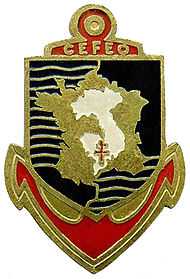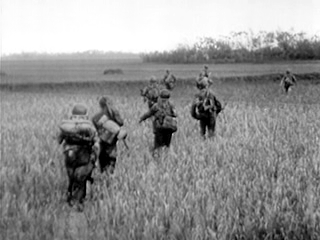French Far East Expeditionary Corps

| ||||||
The French Far East Expeditionary Corps (French: Corps Expéditionnaire Français en Extrême-Orient, CEFEO) was a colonial expeditionary force of the French Union Army that was initially formed in French Indochina during 1945 during the Pacific War. The CEFEO later fought and lost in the First Indochina War against the Viet Minh rebels.
History
Pacific War (1945)
The CEFEO was created in early 1945 as a replacement for the older Far East French Expeditionary Forces (Forces Expéditionnaires Françaises d'Extrême-Orient, FEFEO). Its purpose was to support Saigon-based General Gilbert Sabattier, divisional commander of colonial "Indochina French Forces" (Forces Françaises d'Indochine)[1] and Free French Forces resistance small groups C.L.I. then fighting with the Japanese Southern Expeditionary Army Group during the Second French Indochina Campaign. After the 1944 Liberation of France and the fall of Nazi Germany in Europe the following year, the French authorities wanted to "free" the last Axis powers occupied territories in Southeast Asia, these included the newly established Empire of Vietnam, which was a Japanese colony. On June 7, 1945, Leclerc was nominated commander of the CEFEO. On June 22, Leclerc transferred command of the 2nd Armored Division (2ème D.B.) -the famous unit which had liberated Paris in August 1944- to Colonel Dio. Leclerc received command of the Far East French Forces (Forces Françaises en Extrême-Orient) on August 15.
First Indochina War (1946–1954)

In 1946, nationalist, then communist popular rebellion movement rose up against established colonial rule in the French Indochina federation then including the Kingdom of Laos, the Kingdom of Cambodia, Tonkin (North Vietnam), the Empire of Annam (Middle Vietnam) and Cochinchina (South Vietnam), all states being protectorates excluding the latter which was a colony with Saigon as its capital. In 1946, they would become associated states within the French Union and by 1949 Tonkin, Annam and the Republic of Cochin China would merge as the State of Vietnam. The communist Viet Minh led by Ho Chi Minh overwhelmed its rival nationalist movements and organized itself as a guerilla army using guerrilla warfare, then in the 1950s—due to a massive Chinese support—using conventional warfare. The First Indochina War officially lasted from November 20, 1946 until July 20, 1954 and was settled by the Geneva Agreements.
Dissolution (1956)
After withdrawal of the last CEFEO troops from the independent Vietnam, Laos and Cambodia in 1956, the corps was disbanded by General Pierre Jacquot.
Composition
The CEFEO was made of enlisted and volunteer troops from the French Union colonial territories in Maghreb, Africa, Madagascar, Overseas (future Dom-Tom) and South-East Asia with the notable exception of the French Foreign Legion gathering mostly European troops (French, Spaniards, Poles, and notably Germans etc.).
Most of the professional colonial airborne units (BPC) and the entire Chief of Staff were metropolitan French.
In early November 1953, the French U.N. volunteers returning from the ended Korean War joined the French Union CEFEO and sailed from Incheon to Vietnam.[2] They would be later involved in the battle of Mang Yang Pass of June and July 1954.
CEFEO commanders

- Philippe Leclerc de Hauteclocque (1945–46)
- Jean Etienne Valluy (1946–48)
- Roger Blaizot (1948–49)
- Marcel Carpentier (1949–50)
- Jean de Lattre de Tassigny (1950–51)
- Raoul Salan (1952–53)
- Henri Navarre (1953–54)
- Paul Ély (1954–55)
- Pierre Jacquot (1955–56)
Far East Forces
Groupe d'Opération Nord-Ouest (GONO)
(North West Operation Group)
- GONO commander: General Christian de Castries (1954)
Forces Terrestres en Extrême-Orient (FTEO)
(Far East Ground Forces)
- FTEO commander: -
- Forces Terrestres du Nord Vietnam (FTNV)
(North Vietnam Ground Forces)
- FTNV commander: General René Cogny (1954)
- Forces Terrestres du Sud Vietnam (FTSV)
(South Vietnam Ground Forces)
- FTSV commander: -
Among the French ground forces in the Far East was the 6th Engineers Regiment (6 RG).
Forces Maritimes en Extrême-Orient (FMEO)
(Far East Naval Forces)
- FMEO commander:
- Georges Thierry d'Argenlieu (1946–47)
- Emile Bollaert (1947)
- Vice-Admiral Auboyneau (1952–54)
- Direction Navale d'Extrême-Orient (DNEO)
(Far East Naval Direction)
- DNEO commander: Contre-Admiral Bosvieux (1952)
Forces Aériennes en Extrême-Orient (FAEO)
(Far East Airforces)
- FAEO commander: -
Other aircraft supplied to the French in Indochina in 1950-51 were Martin B-26 Marauders that went to Bomber Group 1/25 "Tunisie", Douglas B-26 Invaders, Bell P-63 Kingcobas, Douglas C-47 Dakotas that went to Transport Group 1/64, 2/64, 2/63 which had both C-47s and C-119th Packets (but these were only operated by US civilian pilots of Civil Air Transport), former U.S. Navy Grumman F6F Hellcats that went to 11th Carrier Assault Flotilla (on Arromanches until April 30, 1954), Curtiss SB-2C Helldivers that went to 3rd Carrier Assault Flotilla (on Arromanches until April 30, 1954), Grumman F8F-1B Bearcats that went to Groupe de Chasse (Fighter Group) 1/22 "Saintonge" and Group de Chasse 2/22 "Languedoc", PB4Y2 Privateers that went to the 28th Bomber Flotilla, and Vought F4U Corsairs that went to 14th Carrier Fighter Flotilla (on Belleau Wood on May 1, 1954).[3]
At the beginning of April 1954, Lt. General Earle E. ("Pat") Partridge, Commander of the U. S. Far East Air Force (FEAF), had arrived in Saigon and begun talks with his French counterpart, Gen. Lauzin, as well as with Gen. Navarre.[3] He had brought with him Brigadier General Joseph D. Caldara, then the chief of the FEAF Bomber Command—the man who would fly and command the "Vulture" missions (bombing the area around Dien Bien Phu with 98 B-29 Superfortresses).[3] The Americans had arrived at Saigon's Tan Son Nhut Airport in a discreet Boeing B-17, so as not to alert hostile eyes to the unfamiliar configuration of the B-29 Superforts. From the beginning, the Americans were appalled at the total lack of French preparedness for anything like the control of a major saturation bombardment operation.[3] French Col. Brohon later said that this project involved the use of "several A-bombs" in the Dien Bien Phu area.[3]
Caldara decided to judge the situation for himself. On April 4, 1954, in the dead of the night, he flew his B-17 with an American crew over the valley of Dien Bien Phu, repeated the mission later with a French C-47 Dakota; and then once more with the B-17.[3] The overall plan was simple enough; the two wings of B-29s from Okinawa and the one from Clark (Philippines) would rendezvous east of the Laotian capital of Vientiane, head for their target; and exit from Indochina via the Gulf of Tonkin.[3] The French at the highest levels seemed to have no idea of the awful destructive power of the 98 Superforts.[3] This bombing mission died a slow death as Winston Churchill was against it, but LBJ was Called Scuttler of this 1954 Bombing.[3] Late that month on 29 April 1954 C-124 Globemasters from the 322nd Air Division were in the process of air-lifting into Indochina the brand-new 7th BPC (Bataillon de Parachutistes Coloniaux), en route from Europe to Vietnam via Colombo, Ceylon.[3] Thus U. S. Air Force aircraft and personnel were actively involved in Vietnam in 1954.[3]
Notable personnel
- Jacques Massu (10e DP)
- Marcel Bigeard (6e BPC)
- Roger Trinquier (GCMA)
- Jean Sassi (GCMA)
- Pierre Schoendoerffer (SCA)
- Raoul Coutard (SPI)
- Mohamed Oufkir
See also
Notes
- ↑ Martin Thomas (1997). "Journal of Southeast Asian Studies, Vol. 28, 1997". Retrieved 2010-01-02.
- ↑ Departure of the French U.N. Korean battalion, French newsreels archives (Les Actualités Françaises), November 5, 1953
- ↑ 3.0 3.1 3.2 3.3 3.4 3.5 3.6 3.7 3.8 3.9 3.10 Fall, Bernard B. (2002). Hell in a very small place the siege of Dien Bien Phu (2nde ed. ed.). New York, N.Y.: Da Capo Press. pp. 293–311. ISBN 978-0306811579.